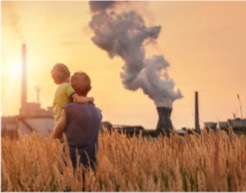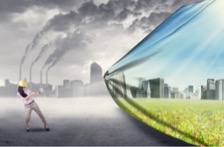A guest post by L. Ciancarella
The following post is one of a series previewing the research that will be presented at the in Rome, Italy (13-17 May 2018).
Atmospheric pollution is a matter of chemistry, not only because human and natural activities emit chemicals, but also because the atmosphere is a chemical reactor with the meteorological and climatic variables activating and/or catalyzing molecules’ transformations.

Photo by the ENEA Report “Effect-based activities on air pollution: What is the
state of the natural and anthropogenic Italian ecosystems?”
Ed. D’Elia et al., 2016, ISBN 978-88-8286-344-9
The emitted substances react in the atmosphere producing in some cases “de novo” substances not directly emitted by human activities (as in the case of ozone, O3), and in others modifying the “primary” composition of the pollutants with “secondary components” (this is the case of particulate matter, PM).
The altered composition of the atmosphere is what we call atmospheric pollution, which affects human health, ecosystems, and leads to the deterioration of sensitive materials on buildings and cultural heritage. This results in significant economic impacts that, although difficult to be assessed, finally begin to be quantified: The Organization for Economic Co-Operation and Development (OECD) estimates that the total cost of outdoor air pollution in the region OECD member states amounts to 1,280USD per capita for 2015, corresponding to about 5% of world or EU income (source: European Environment Agency, Air Quality in Europe 2017). The largest share on these costs relate to premature mortality and morbidity. Estimates indicate that, in 2014, 502,351 premature deaths in Europe are due to long-term exposure to air pollution, specifically 399,000 are related to fine particulate matter (PM2.5), 75,000 to nitrogen dioxide (NO2) and 3,507 to ozone (O3).
Even if there is a substantial decrease of pollutants’ total emissions and resulting atmospheric concentrations, PM2.5, NO2 and O3 still represent a challenge in Europe, and the EU’s limit values continue to be exceeded in large areas of the continent, especially in urban areas.

Photo by the ENEA Report “Effect-based activities on air pollution: What is the state of the natural and anthropogenic Italian ecosystems?”
Ed. D’Elia et al., 2016, ISBN 978-88-8286-344-9
Single emissive sectors, such as industry, residential heating, transport, etc., weigh differently in the relative contribution to primary pollutants (precursors, directly emitted from the source) and secondary ones (pollutants generated by chemical or physical reaction in the atmosphere). This is particularly true for the chemical composition of particulate matter. The understanding of how particulates are emitted and formed in the atmosphere is fundamental to correctly link PM concentrations (both measured and modeled) with the responsible emissive sectors, and target the more efficient mitigation measures.
At the same time, the chemical and physical characterization of atmospheric primary and secondary pollutants could increase our understanding of the health impact associated with air pollution, allowing more detailed risk assessments and the testing of new toxicological approaches aimed at identifying the airborne chemicals with higher impact on exposed populations, particularly if this knowledge is connected to time- and space-defined exceedances.
Session: Air pollution, biomonitoring, and human health
15 May 2018 | 8:30 a.m.–12:25 a.m. | Room O
